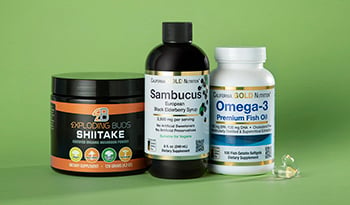This Is the #1 Thing To Look For When Choosing a Multivitamin
DISCLAIMER:This blog does not intend to provide diagnosis...
- In this article:
- Multivitamins, a Historical Overview
- What Is a High Potency Vitamin?
- What to Look for When Choosing a Multivitamin
- Common Multivitamin Side Effects
- Choosing the Right Multivitamin, the Big Picture

With so many multivitamins to choose from on the market, it can be difficult to know which one is best for you. This article will explore the vast world of multivitamins and what you should look for when selecting the best one that fits your nutritional needs.
Multivitamins, a Historical Overview
In the early 20th century, only carbohydrates, proteins, and fats were recognized as essential nutrients in food. Due to poor hygiene, disease ran rampant during this time and food was sanitized to decrease bacteria. Unfortunately, the sanitation practices such as polishing grains and sterilizing milk destroyed many of the vitamins present in food. Vitamin B deficiency with resulting nerve damage and scurvy from vitamin C deficiency was on the rise and becoming quite common.
Scientists discovered foods contained more than just carbs, proteins, and fats in 1912. “Accessory substances” was the name given to these extra nutrients before the term “vitamine” was used and then finally the term “vitamin” was coined and is still used today. Casimir Funk is credited with discovering vitamins. He theorized that many diseases could be cured with vitamins found in foods.
The first multivitamin was formulated in 1915 by a U.S. doctor named Forrest C. Shaklee. He sold the product as “Shaklee’s Vitalized Minerals” until 1929 when he began using the term “vitamin”. The first one-a-day multivitamin made its debut on the market in 1943, and by the mid-1950s, multivitamins were commonly promoted to accompany meals on the dinner table.
Over the years, multivitamins have developed into a variety of different formulations with varying sources being used to obtain the vitamins and minerals themselves. In 1973, the company MegaFood pioneered the way for using food to extract vitamins as opposed to using synthetic ingredients. Other companies also began using plant-based ingredients to create more natural multivitamins in the 1970s.
In today’s market, we have even more innovative options such as soy-free, gluten-free, dairy-free, organic, vegan, and more. One of the latest trends in multivitamins is the high potency vitamin. What does that really mean, and how do you know if your vitamin is high potency?
What Is a High Potency Vitamin?
Defined by the FDA in 1997, ‘high potency’ may be used on a product label to describe individual vitamins or minerals that are present at 100 percent or more of the reference daily intake (RDI) per reference amount customarily consumed. Another way of saying this would be if the vitamin meets 100% of the RDI, then it can be labeled high potency.
Taking a high potency vitamin is important because they are meant to be supplemental. Meaning, if you are not getting all of the vitamins and minerals you need from your diet or what you are eating daily, then taking a multivitamin can supplement those nutrients you are missing from your food intake. If you are supplementing missing vitamins and minerals, then you want the multivitamin to provide the RDI for each nutrient.
What to Look for When Choosing a Multivitamin
Now that we know to check the label of your multivitamin to determine if the ingredients are at 100% or more of the RDI to confirm we are taking a high potency product, what else should you look for when choosing a multivitamin?
1. Ensure Your Multivitamin Has the Nutrients That You Need
If you have been diagnosed with a nutritional deficiency such as vitamin B or vitamin D, you want to ensure your multivitamin has a high potency of the nutrient you are lacking.
Also, you want to make sure the vitamins support your goals and lifestyle. For example, if you want to boost eye health, vitamin A is important. Similarly, if you have diabetes, biotin may be a good ingredient you want to look for in your multi. Another ideal ingredient for diabetics is chromium. Chromium is a trace mineral that may improve insulin sensitivity and carbohydrate metabolism.
If you are pregnant or want to become pregnant, a multivitamin high in folate, or B9 and B12. Both are essential in preventing birth defects
2. Antioxidants Are Key to a Good Multivitamin
Vitamins such as vitamin E and vitamin C are powerful antioxidants that help protect your body from free radicals. Free radicals cause your cells to age faster and cause damage to the cells as well. Free radicals play a part in heart disease and other chronic conditions.
Vitamin E also plays a key role in many other functions of the body including vision, brain, skin, and reproductive health. Vitamin C is needed for the proper growth and repair of your body tissues and has a significant influence on proper immune function and wound healing. Your teeth, bones, collagen, and cartilage all depend on vitamin C for development and maintenance.
Alpha-lipoic acid is another great antioxidant that may improve nerve function, reduce inflammation, slow memory loss progression, and lower the risk of heart disease.
Lycopene is another powerful antioxidant that should be on the ingredients list of your high potency multivitamin. Sun protection is another positive benefit of lycopene consumption. For those with metabolic syndrome, lycopene can help decrease their risk of premature death. Decreased risk of heart disease is yet another benefit of lycopene supplementation.
3. Choose a Multivitamin That Helps You Produce Energy
Pantothenic acid, also known as vitamin B5, helps convert your food into energy. This special nutrient also aids the body in fat metabolism.
Vitamin B12 is another energy-boosting nutrient that should be present in your multivitamin. B12 is critical for red blood cell formation and helps prevent anemia. Anemia causes fatigue in the majority of patients. In addition to its energy stimulating effects, vitamin B12 also supports healthy pregnancy by preventing birth defects. You can reduce your risk of macular degeneration, osteoporosis, and depression with adequate B12 levels.
Chromium also provides energy support by helping to convert proteins, carbs, and fats into energy your body can use.
Boron is a trace mineral that helps to support strong bones, increased testosterone levels, and boost athletic performance.
4. Select a Multivitamin That Has Some Extra Goodies
Many multivitamins today offer herbs and other ingredients that are not vitamins or minerals for added benefits.
Marigold flower is a good example of an added herb that can be found in a premium multivitamin. Marigold helps increase blood flow, aid in healthy tissue growth, decrease inflammation, and help fight infections.
Plant pigments or flavonoids like quercetin are a smart addition to a daily multivitamin. Quercetin is a powerful antioxidant with allergy-relieving qualities. It is also known to reduce the risk of developing a neurological disorder, heart disease, and infections.
Calming effects can be added to the long list of multivitamin benefits with the addition of apigenin to the formula. Apigenin is a flavone that happens to be the active ingredient in chamomile tea. It may induce relaxation or sedation along with its anti-inflammatory and antioxidant properties. Apigenin is also naturally found in oregano, parsley, artichokes, and spinach.
5. Choose a Multivitamin That Is Right for Your Age and Sex
Depending on your age and sex, you may need more or less of certain micronutrients found in multivitamins.
If you are a premenopausal woman, you may need more iron than a postmenopausal woman or a man. Senior citizens may need more calcium and vitamin D. Men typically need more vitamins A, B, E, and K, as well as zinc, compared to women.
While ideally, children would get enough nutrition from meals and snacks, the modern-day diet may be lacking sufficient vitamins and minerals needed for healthy growth and development. Children need a good amount of calcium for growing bones and fiber for healthy gut motility.
Common Multivitamin Side Effects
When taken properly, multivitamins are not expected to cause serious side effects.
Side effects that could occur from taking multivitamins include nausea, upset stomach, flushing, unpleasant taste, and diarrhea.
If minerals are taken in large doses, side effects including irregular heart rate, confusion, muscle weakness, tooth staining, and increased urination may occur.
Choosing the Right Multivitamin, the Big Picture
Selecting a high potency multivitamin should be the first priority when choosing the right multivitamin for you. Other things to consider are your lifestyle, age, gender, and any vitamin or mineral deficiencies you may have.
Consider any supplemental ingredients such as herbs or flavonoids that may be present in the multivitamin that may provide additional benefits that are desirable for you.
Always talk to your doctor before beginning a new supplement routine, including adding a daily multivitamin to your regimen, especially if you are pregnant, nursing, or have a health condition.
References:
- Schwartz JB. Vitamin intake, recommended intake, and gender differences. J Gend Specif Med. 2001;4(1):11-15.

 By Dr. Carlie Biggins, N.D.
By Dr. Carlie Biggins, N.D.


